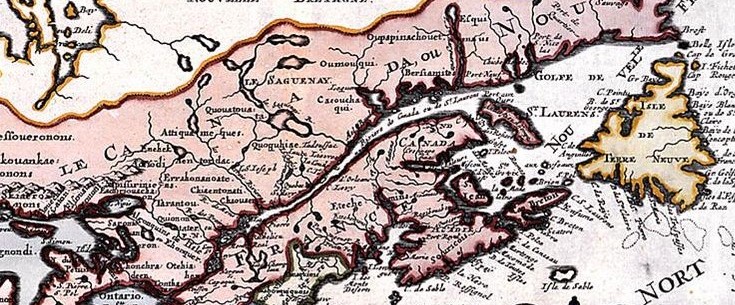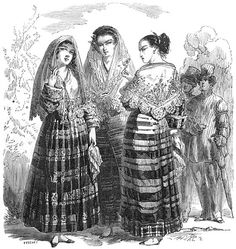MÉTIS HISTORY
![]()
Métis Origins
Our Métis history may be old in our eyes, but it is very young compared to the rest of the world. Unfortunately, Métis history was not taught well in school, and was even hidden in some parts of Canada. It was not in always in shame; it was often the only mean to survive the genocide of the continent's indigenous peoples, especially during the dark years of the Deportation of the Acadians (Le Grand Dérangement) and the Red River Resistance.
In other parts of the country, especially during the last twenty years, Métis history was "re-written" to accommodate political agendas or groups claiming that the birth of the Metis "Nation" stems from the fur trade around Red River, Manitoba in the late 1700s and early 1800s. We offer solid evidence that the roots of Canada's Métis Nation are solidly anchored in eastern Canada. Every serious historian will tell you that our young French ancestors, who spent months at high seas and eventually settled in eastern Canada from the early 1600s onward, did not wait 175 years and the migration of the fur trade to western Canada to take an Indigenous wife and start a family!
Some peoples debate that being a mixed-blood, or half-breed does not constitute the right to call oneself Métis. Not only do we disagree wholeheartedly, but we consider such statements as racist and discriminatory. The word Métis is not native to the West, but was used by explorers and settlers, including Louis Riel to describe his fellow citizens of the Red River, as well as all other Métis peoples in Canada. The term Métis has its source in a Latin word meaning mixing, weaving. The adjective “métissé” was in fact used first in New France in the 17th century, but it had already taken the form of a noun in the early 18th century, as well as other names, such as mixed-blood, chicot, burnt-wood, Canayen, etc.
The study of the history of the Métis in the east and the west bring to light important differences, and some similarities, but it also shows an important commonalities and truths: a history of upheaval, challenges, and discrimination from sea to sea.
André Lasnier, first Métis born in Canada?
Although born in Canada in 1620, André Lasnier was baptised in France in 1632. According to the baptism record below, he was the son of Louis Lasnier and of a Canadian woman, was the first recorded child born of the union of a European man and an Indigenous woman in Canada. The child was twelve when he was baptized in France. The text below, borrowed from the Yarmouth Vandguard's website and the copy of the baptism record itself, confirms the existence of that Metis child, possibly the first recorded one in Canada.
Learn more about ANDRÉ LASNIER

INVITATION TO SERIOUS RESEARCHERS AND ACADEMICS
We invite historians, historical authors, and serious researchers to contribute their work to this page to help people understand who is Métis.
Contributors
1 - The Birth of a People: Martin Carrière
2- The First Metis People: Karole Dumont.
3- Canada's Western Métis: invitation to submit your research.
THE BIRTH OF A PEOPLE.
By: Martin Carrière, Nov. 2017
The indigenous tradition of marrying off their daughters and sons to gain military, trade and cultural advantages is the environment from which the first Metis peoples arose. From Champlain's overtures of alliance from 1608 onwards offering to make “one people” through the merger of the French with the Algonquin, Mi'kmaq and Iroquoian speaking nations, the formal sanction for the emergence of the Metis was set.
The mutual adoptions and exchanges of warriors following battles through to the forming of the Great Peace of Montreal in 1701, with close to 100 nations agreeing to all live peacefully together with the French speaking allies, brought the Metis firmly into existence. Living with the old nations from birth, the new families of Metis learned all their indigenous families’ languages, traditions, and ways of surviving. The Bois Brulés, Coureurs des bois, Voyageurs, and merchants brought great wealth and losses in different forms to the old nations and to the Europeans. The old nations gained some military advantages, yet lost more through the introduction of European diseases and the ongoing feudal wars. Other wars, primarily between the English and the French, included all the nations of the old world, and were for control of the territories of the old nations. The Europeans gained much needed settlement lands and tax revenue, yet lost control of the Dream of “one people” as the old ways of racism and prejudice encouraged the Metis to continue to live free and strong.
Being born with genetic diversity and resilience to European diseases, the Metis families flourished and spread with the expansion of the trade from the east, to the south, to the north and to the west. Walking hand in hand more with the Cree, Chippewa, Assiniboine and other allied families, the Metis continued to strengthen their family ties to become the largest indigenous merchant family in North America. Through the loss of French control over the trade in 1763, the Michif speaking Metis merged with the French speaking British founders of the North West Company to control the majority of the trade in North America over the next three generations. In 1810, the Royal Society reported to the English Crown that the Metis were resistant to European diseases and were more able to compete against the less acclimatized Europeans, so the removing of the Metis as a threat to European settlement became the primary policy of the English hierarchy.
From the forming of the American states to the sale of Louisiana through to the war of 1812 and after, the expulsions of Metis and our allied families from the east and south as English and American law displaced thousands from their homes, their inheritances and their territories, created a permanent unrest and resistance within the Metis against further insult and degradation.
With close to 500 Metis enlisted in the Canadian militia to defend the trade territories in Canada during the war of 1812 the British and Americans witnessed the Metis combat skills first hand. During the war, the Metis also supplied a good portion of the annual harvest of Pemmican to feed the British and Canadian military. The theft by the British HBC of the Metis harvest of pemmican in 1813 showed the complicity of the purveyors of English law and the urgent need for the Metis from the east to the west to step forward to defend against any further depredations and to protect all Metis. From the military-trained Metis from across the country, three Metis regiments were created and funded by the NWC to protect the essential national trade routes and depots of lake Athabasca, the forks of the Red and Assiniboine rivers, and the areas around Thunder Bay and Sault Ste Marie. The infinity symbol of the Metis flag first flown at that time represents the unity and strength for all Metis, from all the combined Metis families, to persevere by standing strong together to protect all Metis, in whatever territory they are in.
The Metis traditions of growing gardens around their homes, actively hunting, fishing and engaging in the trade and other endeavours while generously sharing with their community and family still continues today. Trading in pemmican, furs, horses, sashes, bead-work, quill-work, and limitless trade goods the Metis families would travel extensively and meet by the thousands annually at rendezvous gatherings in various locations across the continent. Learning the connection to the land from our indigenous grandmothers and grandfathers, and the inherent responsibilities, all Metis have to keep the circle of life sacred, is who the Metis really are. That connection is what many believe to be what sets the Metis apart from their European cousins, who have forgotten the respect and sacred bond all people hold to the earth and to all of Creation. The uniting of the Metis families to protect the land, resources and way of life is part of the defense the Metis families have waged continually against the predatory mindset of the European-based systems that do not have any conscience about the destructiveness they bring about. Losing their homes and rights to inherit land and property with the advent of English law from the mid 1700's to 1806 onwards, in Upper and Lower Canada, and the strong influx of new settlers, pushed many Metis to obtain English-based title to the land to protect themselves and build their homes onto it while they were engaged in the trade economy in the west. Many of these Metis still had homes and extensive family in the East.
Mixing with the English-speaking populations was not an easy road and much discontent ensued. The challenge of the British North-America Act-based Canadian push to again disregard the Metis inherent right to land, law and liberty in 1869 and 1870 saw the Metis flag again used to defend the Metis and other indigenous people against persecution that resulted in the forming of the province of Manitoba. This battle was a means to entrench and protect the inherent rights to language, culture and traditions of the Metis and their cousin nations.
Fighting the cultural arrogance of the European mindset as the Metis did in 1870 is what inspired their cousin nations of Cree, Dakota, Assiniboine and others to stand with the Metis during the “Defense of the West”, or the “Northwest Rebellion” in 1885. After watching the destruction of the buffalo herds, the continued desecration of sacred monuments and territories and the imprisonment and death of so many families all indigenous nations knew their way of life in living in sacred harmony with the earth was being destroyed. Losing that battle in 1885 may well have made the Metis fall asleep for 100 years, yet the real war has never stopped.
The responsibility and accountability the Metis hold to all their cousin nations from the east to the west is the real inheritance of the Metis. Standing tall together with all their cousin nations, in all the shared and sacred territories across this land, to defend the earth and all of Creation against the ongoing destruction is the real awakening of the Metis. Uniting all their families, whether they are from known Metis families, or from families who hold full nation status, or families who are non status, or families who are just rediscovering their roots within the Metis, and who want to stand strong with the Metis together is the beginning of the reconnecting of the full Metis family.

THE FIRST MÉTIS PEOPLE
By: K. Dumont – 10/2017
The first Métis People emerged in eastern Canada in the early 1600s with the arrival of European explorers and their unions with Indigenous women. One of the earliest Metis baptisms found was for André Lasnier, born in 1620 in Port Latour, Nova Scotia, but baptized in France in 1632.
The primary commerce was fishing, but the fur trade quickly claimed its place in New France’s economic development. Some of the original Metis communities were rooted in La Have, Port Royal, Cap Sable, Trois-Rivières, Québec and Montréal, where they developed a unique identity, history, culture, and in some cases their unique language. The various conflicts and wars between the French, the British, and the First nations caused havoc among the colonies, the Metis, and the First Nations. The 1755-1763 deportation of the Acadians, many of whom were Metis, is a somber period in our history that is poorly taught in our schools. Shortly after that genocide wave, the near extinction of fur-bearing animals in eastern Canada pushed the fur trade westward, opening new routes and settling new Metis communities along the way.
Those who remained in the east faced more military conflicts that forced some families and communities to “hide in plain sight”. The French-Indian wars (1754-1763), the American Revolution (1775-1783), the War of 1812 (1812-1815), and the Patriots rebellions (1837-1838) were but a few of the numerous conflicts that reshaped Canada’s landscape before Confederation. By that time, very few eastern Metis – if any - dared to stand up in a crowd and declare “I am Metis” or brandish anything resembling a Metis flag. It was a question of survival! One can only imagine the grief and fear our ancestors faced as more settlers received the land they once roamed upon freely. One can only imagine their feelings of despair in the face of subjugation, and their powerlessness to maintain their true identity.
It took a few centuries for the tumultuous waters to settle into some sense of acceptance, and for the Metis to act upon a profound desire to reconnect to their hidden heritage. Today, the Canadian Metis Nation has evolved in cultural diversity, not unlike the First Nations who, while being an Aboriginal People, have different Nations, different cultures, traditions, languages and beliefs. There is no such thing as a “one size fit all” Metis, no more than there is “one size fit all” First Nations, but the one thing all Metis peoples share is pride in their identity, their ancestors, and their history.
![]()
THE MÉTIS OF WESTERN CANADA
There is so much work on Métis in Western Canada that we invite our visitors to submit their own research or analysis, or the work of other researchers - with permission of course

Literature
The following section offers published work from various authors, all available on the internet. **Note: Finding these works on our site does not mean that the CFMPC agrees with all the authors. This list encourages awareness and awakening to our history. Unfortunately, not all resources are available in English and French.
NOTE: Please contact us to obtain a copy.
- The indefensible in-betweenness or the spatio-legal arbitrariness of the Métis fact in Quebec (Étienne Rivard, 2017)
- An Ethnographic Report on the Acadian-Métis 2018 (Christian Boudreau)
- Comission D'enquete Viens
- Communautés mixtes Cote Nord A-2018-00145
- Du Dunn Martin - The Other Metis A201701143_ nn Martin - The Other Metis A201701143_
- Ethnogenèse Des Premiers Métis Canadiens, Denis Jean
- Displaced Mixed-Blood: An Ethnographic Exploration of Metis Identities in Nova Scotia (Katie K. MacLeod)
- Entretien avec John Ralston Saul : L'Acadie Métis, Chapados, Emmanuelle . L'Étoile Shediac ; Richibucto, N.B. [Richibucto, N.B]23 Apr 2009: C.10.
- Les familles pionnières de la Nouvelle-France, Jean-Paul Macouin
- Les Inuit du Labrador 1850s, Paul Charest
- Métis Environmental Knowledge, Carol Leclair
- Métis Perspectives - The other Metis, Martin Dunn
- Métis-Acadien, Gerald Vizenor
- Métissage in New France, Devrin Karahasan
- Bonds Of Money, Bonds Of Matrimony?:French And Native Intermarriage In 17th & 18th Century Nouvelle France And Senegal, Eugene Richard Henry Tesdahl
- The Other Metis, Martin Dunn
- Negotiating an Identity: Metis Political Organizations, the Canadian Government, and Competing Concepts of Aboriginality, Joe Sawchuk
- Prairie and Quebec Metis territoriality , Etienne Rivard
- The French Relationship with the Native Peoples of New France and Acadia, INAC
- Les relations franco-amérindiennes en Nouvelle-France et Acadie, AANDC
- Report of the Royal Commission on Aboriginal Peoples
- Ni Amérindiens ni Eurocanadiens. Une approche néomoderne du culturalisme métis au Canada, Emmanuel Michaux
- La Mouvance Métisse au Québec : Vouloir Être ou Ne Pas Être Métis, Mémoire présenté comme exigence partielle de la Maîtrise en Science Politique, Simon Villeneuve
- Metis Acadian Heritage 1604-2004, Roland Surette
- The Metis in Southwestern, Nova Scotia, William Wicken.





